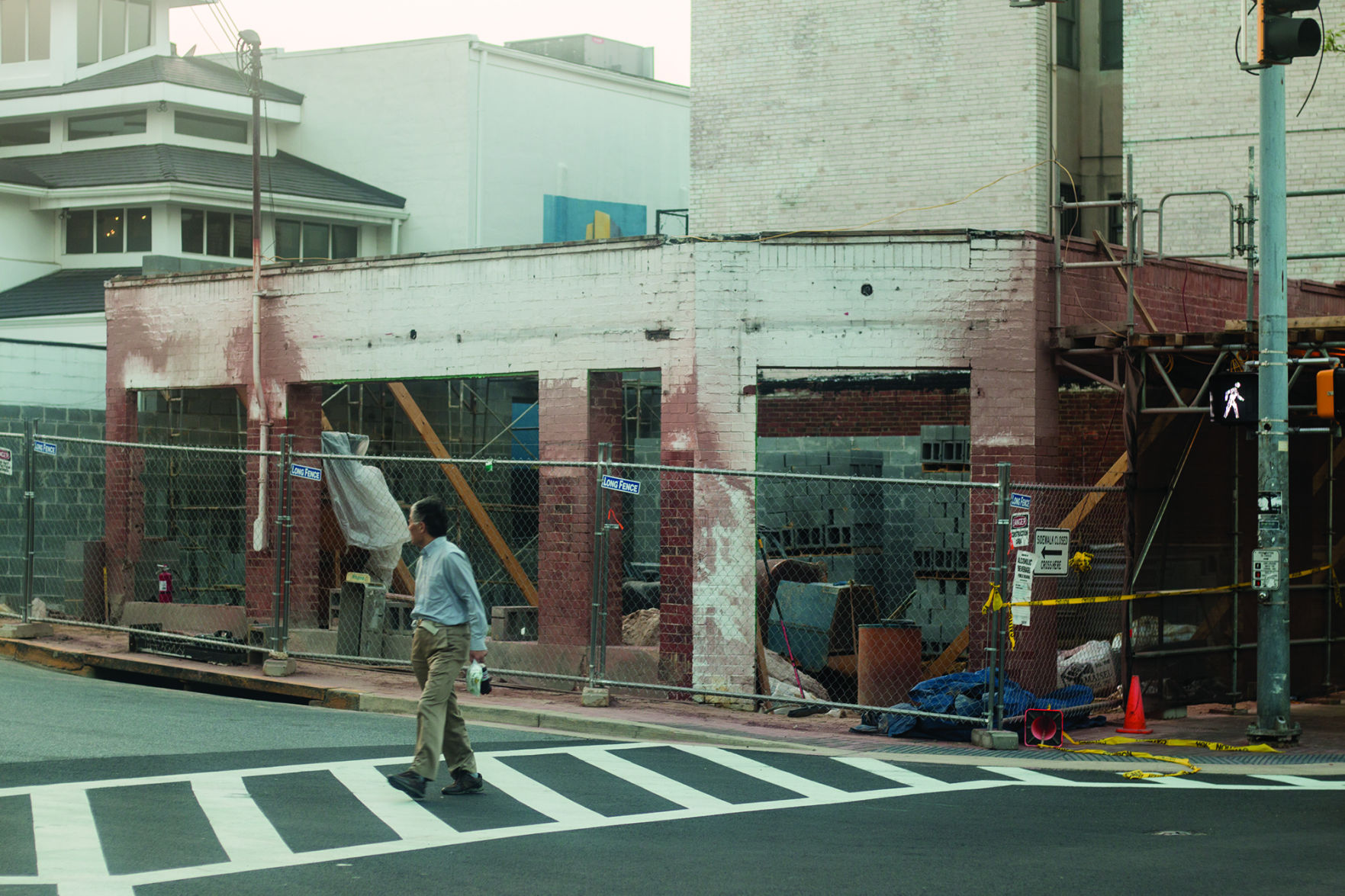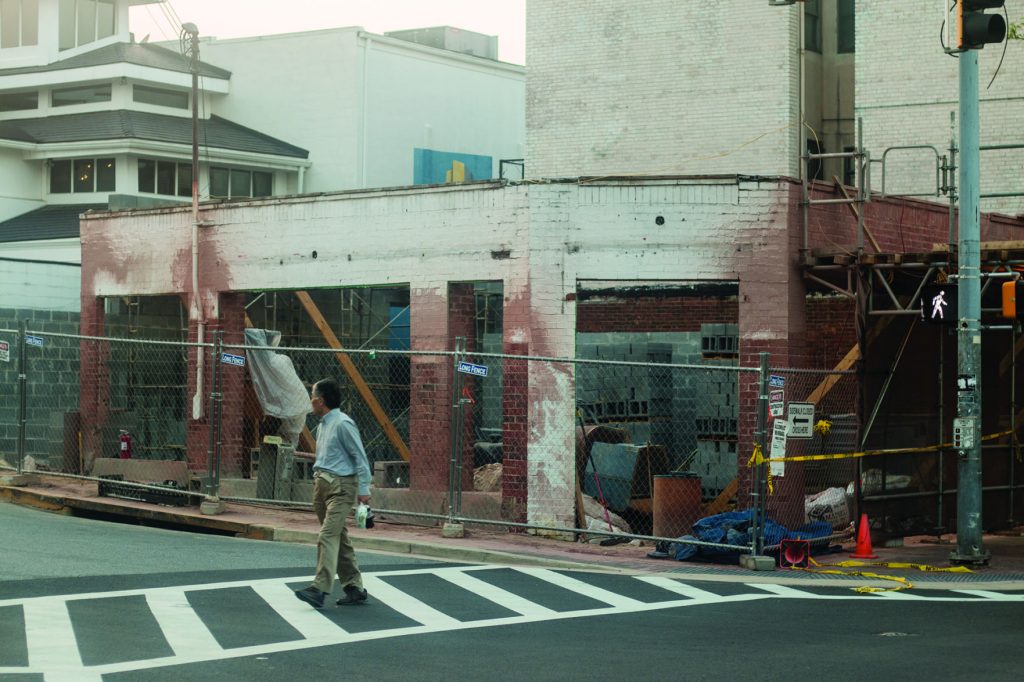It’s Saturday night in College Park, and something is missing.
Cars whiz past the glowing green light over Knox Road. Kids and cops hang out on the corner of Knox Road. Bright neon pierces the dark facades lining the Route 1 corridor that borders the university, but the sparkling nightlife is just a little dimmer.
Where a comforting Terrapin eatery used to glow invitingly sits a construction site now vacated for the night.
Every school year, another business closes its doors, another neon sign turns off for good and another space is open for a business to try to make it in College Park.
Ratsie’s Terrapin Eatery closed on April 4, joining the ranks of the dozens of restaurants that took a crack at the College Park market, only to quickly pack up and go home.
Though Ratsie’s closed because owner Mike Falamoun was ready to retire, its exit indicates that even the most beloved spots aren’t immune to College Park’s challenging economic climate.
REASONS FOR FAILURE
In the past two years, more than five popular College Park eateries have closed for good. The former site of Garbanzo Mediterranean Grill is still looking for a new tenant. Lime Fresh Mexican Grill (which itself replaced California Tortilla) has already been replaced by Blaze Pizza. Roti Mediterranean Grill is now The Board and Brew, a board game cafe.
Even the city bars have called it quits: The Barking Dog ceased operations in November 2013 and could house a new university-sponsored art house. Big Play Sports Grill, one of several restaurants to occupy the corner of Route 1 and Hartwick Road, closed in the fall.
Is there any cohesion to these closings? Is this normal? Yes, and at the same time, no, says Michael Stiefvater, College Park’s economic development coordinator.
“It’s kind of just the nature of retail,” Stiefvater said. “It changes often. People are into different types of cuisine.”
In an urban retail climate, the average restaurant takes a few months to stabilize, and many restaurants don’t make it to a year, Stiefvater said.
A number of things cause restaurants to fail: bad food, bad management or unpreparedness for a competitive market.
Many owners don’t have enough funds to fall back on when business slows or students leave for break, Stiefvater said. Even the tastiest products or most popular ideas can falter if the eatery’s management can’t correctly price a menu or budget for supplies.
So what sets College Park apart from other college towns?
For one thing, it’s retail- and restaurant-saturated.
“The university was more a commuter school back in the day,” Stiefvater said. “Students weren’t really here, and the population wasn’t nearly as high.”
For years, the city catered to commuting students’ interests in the most gastronomic sense of the word. College Park, namely the stretch of Route 1 that borders the university, is also home to more than 80 restaurants, ranging from fast-casual Mexican to Vietnamese-Thai fusion to modern vegan to, of course, pizza.
The focus wasn’t on the long term, Stiefvater said, and now, the city is playing catch-up.
Additionally, College Park, specifically the downtown area, is an expensive market for a startup. In the most lucrative sections, annual rent is between $30 and $60 per square foot, not including utilities.
To put this in perspective, West Lafayette, Indiana, home of Purdue University and a city similar in size and urban positioning to College Park, charges a maximum of $18 per square foot. Madison, Wisconsin, another college town and major metropolis, only sees rates reach $47.
“College Park rents aren’t cheap,” Stievfater said, “so you have to have a good product in order to compete in business.”
The key to failure, however, might lay with the university year itself, said Michael Myers of Curtis Investment Group Inc., a firm that owns the properties between College Avenue and Lehigh Road. These include Wasabi, Bagel Place and Blaze.
This university has one of the longest winter breaks of any Division I school in the country, Myers said. This past school year, it lasted from Dec. 20 to Jan. 26.
“There’s no planning,” he said, “so when it gets to the time the kids leave and the school shuts down, unless they build a clientele like the Bagel Place, they haven’t done enough research, business-wise.”
University dining plans also hinder College Park from tapping the student body’s enormous buying power.
About a quarter of the student population is required to pay more than $2,000 a semester to receive more than 1,000 dining points that cannot be rolled over, exchanged or returned if unused at university dining halls.
“[Owners] don’t understand that all the freshmen have to have a meal plan,” Myers said. “Wipe out the freshman and you’ve only got three classes.”
Though not required, many sophomores do this as well. Thus, restaurants have a largely reduced portion of the student population to attract and sell to — an unavoidable fact that many owners seem to avoid.
Gabriel Metzger, a junior communication and theatre major, said having a dining plan deters him from traveling into the city for meals.
“I don’t want to waste the money,” said Metzger, who this past year paid for a partial dining plan at Hillel, a Jewish student group that offers kosher meals. “If I’m paying for a meal plan, I should use that entire plan.”
Many establishments also get caught in an alcohol trap, going through expensive, painstaking bureaucratic processes to obtain a liquor license that doesn’t often yield many benefits, Myers said. Where owners see a gold mine of ravenous and irresponsible students in their 20s, they should exercise caution, he said.
“[Lime Fresh Mexican Grill] was banking a portion of their revenue on their liquor sales,” Myers said. “Only a small portion of the students are old enough to drink, and everyone else is underage.
“It just never took off.”
BEHIND IN THE BIG TEN
The only Big Ten town smaller than College Park by 2013 U.S. Census numbers – doesn’t have an Urban Outfitters, and it only has six bars, West Lafayette, Indiana, Economic Planner Chandler Poole said, and those are problems.
While there is plenty to eat, compared with other schools in the Big Ten, College Park is lagging. There are only two clothing outlets, Rugged Wearhouse and the University Shop. For entertainment purposes, students and residents can pick between bowling at AMF College Park Lanes or bowling at TerpZone.
While the retail, food and service industries compose the majority of businesses here, in other towns, the focus is elsewhere.
West Lafayette, Poole said, is a “knowledge industry” town. It struggles to land big retailers but seldom feels the effects of financial downturn because of its number of small high-tech research companies.
In addition, the town recently annexed Purdue University, creating a lucrative partnership that has allowed Poole to not only attract bigger retailers, but also fund an expensive road-development project.
“My economic climate is very solid, because my industry is the university,” Poole said. “My mayor put the directive, ‘[The university and the city] will get along, and if we don’t, we will find someone to take your job.’”
While College Park residents might flock to adjacent towns or Washington for entertainment or higher-end clothing not embroidered with the Terps logo, residents of other college towns have options not afforded to locals near this university.
“We try to do programming to bring people,” said Courtney Hayden, communication and special projects coordinator for the borough of State College, home of Pennsylvania State University. “Residents that wouldn’t be here when students are here come back.”
The borough, which features multiple museums, a movie theater and a book and coffee cafe, hosts festivals and community events throughout winter and summer breaks. On New Year’s Day, it hosts a large celebration called First Night that invites residents to the downtown area for a nonalcoholic party. This attracts customers to their city, shops and most of all, dining, Hayden said.
“You’ll see a slowdown [in the winter and summer], but that’s the time when the long-term residents reappear,” Hayden said.
CITY COLLABORATION
University President Wallace Loh meets frequently with College Park Mayor Andy Fellows and the City Council, as the university must seek city approval for all development plans.
“The bottom line to all of this is, all the things we are doing, we are doing jointly with the city and the county for a simple reason: We have to get their approval,” Loh said. “We have to get whatever city approval we need for any construction, any renovation, any project.”
Some of those projects include the upcoming TargetExpress store, The Hotel at The University of Maryland and a new innovation district, located on the former East Campus.

Construction Site
While the hotel will capitalize on a modern retail market all about proximity to housing, Hayden said, the innovation district is a page out of Purdue’s playbook. It will combine contributions from the M Square Research Park partnership with new ideas from faculty and students, said Brian Darmody, this university’s research and economic development associate vice president.
The new district is intended to attract a different breed of College Park customers: corporations with big ideas and big needs for development space.
In the meantime, students have ideas about how to work with what College Park does best.
While Metzger wants a grocery store, junior Ryan Pillai would welcome food with a more authentic flavor — he says the pho restaurants don’t do Vietnamese restaurants justice — and an attractive vibe.
“Ambiance is really important,” said the aerospace engineering major. “[It would] be nice to have a fresh chill area with good music and interesting food.”
Senior mechanical engineering major Ann Savage rejects the idea that College Park students and residents dislike everything that isn’t pizza.
“I would make the argument of ‘Have you ever been to Bagel Place on a Saturday morning?’” she said.
She said that a late-night sweet spot, like the soon-to-open Insomnia Cookies location, fills a need for not only diversity, but novelty.
In addition, she’d like to see a restaurant with a more aggressive marketing campaign.
“Bagel Place also has a kind of brand,” she said. “They’ve marketed themselves well and are also very college affordable, unlike rivals like Starbucks. … Bagel Place is really one of a kind in College Park.”
STAYING RELEVANT
While large-scale redevelopment plans are in the works, some savvy business owners have already taken heed of students and residents’ dissatisfaction with current offerings.
Brian McClimens and Ben Epstein love board games. They love board games so much, they decided to open a restaurant.
“We thought a board game retail shop was too niche,” McClimens said. “We felt that College Park didn’t have a place to hang out with a unique atmosphere.”
The two university alumni and former roommates recalled a long-gone coffeehouse on Route 1. Seeing a void to fill, the two set out to smash the “coffeehouse ceiling” while providing College Park with some long-overdue entertainment.
“The main thing that sets us apart is that we are a recreational spot as well,” McClimens said. “If we were just a restaurant, we wouldn’t have picked College Park as a place to open up.”
The cafe boasts more than 500 board games that, for a nominal fee, customers are welcome to play while grabbing something to eat or meeting friends for coffee.
A few miles down the road from The Board and Brew, Kristi Lee is digging a hole — metaphorically, of course.
When she opened the Southern-inspired Backyard Sports Grill, she envisioned it as a place where College Park residents could come together and feel at home.
“I really want it to be the local watering hole where people, not only students, but people in the community, feel comfortable coming in because they feel like we’re also a part of the community,” she said.
The new bar and grill already has some regulars, Lee said.
“The key is having a good product and filling a gap,” Stiefvater said.
That might be the key to success in any college town, not just this one. Whether providing a place to sit, talk and throw a few dice or somewhere to chow down on Southern cooking among friends and neighbors, restaurants have to reinvent themselves to stay relevant, Myers said.
“If you don’t reinvent yourself, you don’t make it,” he said.
Senior staff writer Ellie Silverman contributed to this report.
The construction site on Route 1 and Knox Road where Ratsies’ Terrapin Eatery stood.
The construction site for The Hotel in College Park on Route 1





